Jamie Gillis would have been 79 years old this week.
Given that he was almost 30 by the time he started appearing in early New York adult films, what had he been doing until then? The answer, not surprisingly, was performing. What is perhaps surprising was that he was first a mime artist in Europe, and then a well-regarded theater actor in Off-Broadway productions, using his real name Jamey Gurman.
The Rialto Report recently acquired previously unpublished photos of this period of Jamie’s life – which we present together with excerpts of our conversations with him and newspaper articles about this time.
——————————————————————
Jamie Gillis – The Mime
Did you always want to be a performer of some kind?
For as long as I can remember. My first exposure to Shakespeare was in the 8th grade when our teacher took some of us to see a group called the Shakespearewrights perform in a nearby church. The theater was intimate, and I loved being able to smell the performers as they strutted and stormed around doing Julius Caesar.
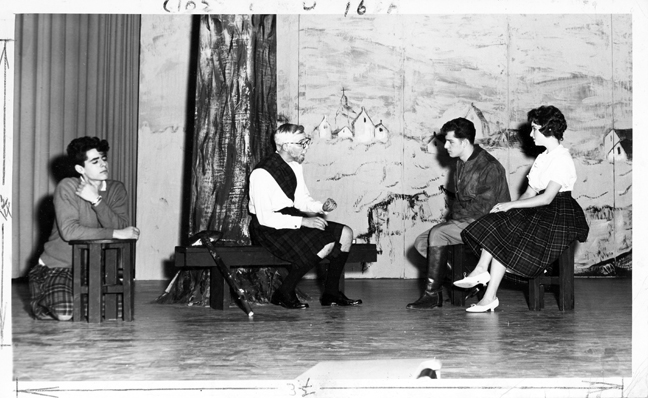 Jamie (left) in a high school production of Brigadoon
Jamie (left) in a high school production of Brigadoon
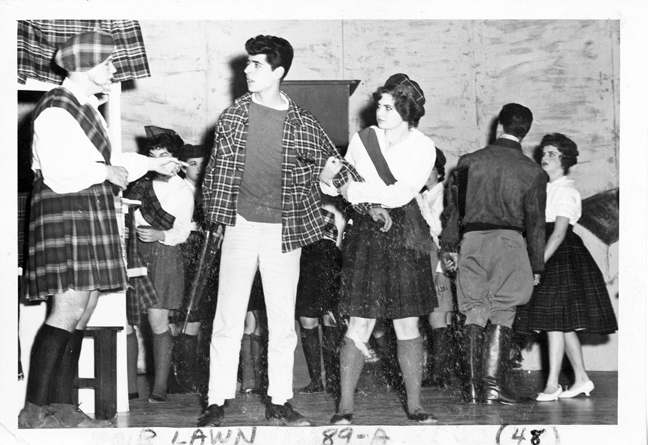 Jamie (middle) in a high school production of Brigadoon
Jamie (middle) in a high school production of Brigadoon
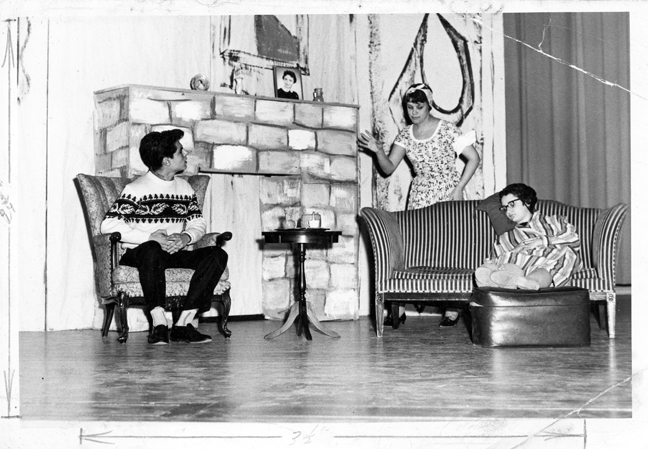 Jamie (left) in a high school production
Jamie (left) in a high school production
What happened when you left school?
I went straight into the theater. I took the name ‘Jamey King’ which I thought sounded regal and important.
Do you remember any of those early plays you did?
One of the first plays I did when I 18 was ‘Rope’, which was the same as the Hitchcock version.
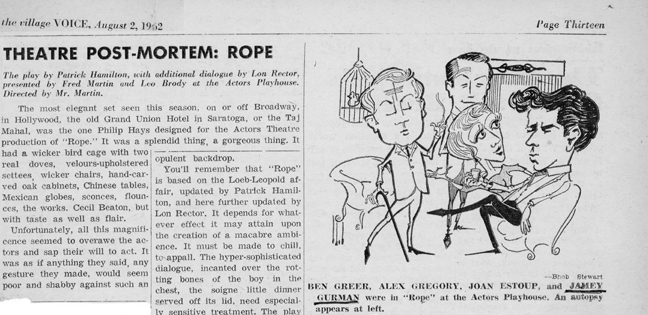 Village Voice article about ‘Rope’ – with a cartoon of Jamie (right)
Village Voice article about ‘Rope’ – with a cartoon of Jamie (right)
Did you have an agent?
Dora Weissman. She was an ancient Yiddish actress, must have been in her 80s. I went to her Performing Arts School, and she liked me, and represented me for a short while.
Ten years later I saw her in Al Pacino’s film The Panic in Needle Park (1971). She was a legendary figure in acting circles in New York.
When did you become interested in being a mime?
Mime was once a revered and respected art form. It’s funny to think that nowadays because mimes are almost universally mocked.
When I left school, I decided that I’d become a Shakespearean actor. I was naïve and innocent, and I thought that Shakespeare was the purest form of art for a performer. I didn’t want to be a sell-out; I didn’t want to be a commercial actor.
Then in 1961, when I was 19, I went to see a Marcel Marceau performance. It changed my life – at least for a while. I used to think that a theater was like a church, but this was like a monastery! After I saw Marceau, I only wanted be a mime. I felt that was the perfect vehicle for my craft.
Did Marcel Marceau remain an inspiration?
For a time, he was God to me. After him, I was a mime. I actually went backstage to see him. I mumbled “Bless you” to him.
After that, I spoke to him several times about the possibility of studying with him but he was always touring and unreachable as a teacher in those years. He seemed to be jealously guarding his talent but always held out hope to the small band of mimes in the world that he would someday have a company and impart his great secrets to us.
So who did you study with?
Everyone. I was serious about learning, so I studied with everyone I could find, often studying with more than one teacher at a time.
My favorite was Tony Montanaro. He hired me to work with him on his one man show, ‘A Mime’s Eye View’ at the Gramercy Arts Theatre in 1962. Then there was Richard Morse, Carlo Mazzone-Clementi, Lionel Shepard, Moni Yakim.
How did you end up doing mime in Europe?
That was in Holland in the early 1960s. I was living in a place on Prinsengracht, working as bellboy at the Victoria hotel. It was a perfect job for me. I ran errands for guests in the red light district, and spent time talking to the prostitutes who displayed themselves in the ground floor windows.
One day I came upon a sign announcing a performance of the Will Spoor Mime Troupe. I went to see the show and afterwards went backstage and told them that I’d studied mime in New York. That was enough of a resume to be immediately asked to join them.
I started seeing a girl named Yeka, a 17 year old, half Japanese ticket taker for the company.
What was Will Spoor’s Troupe like?
There were only five people in the troupe. We bought a tent from a circus performer named Bosco who was retiring. He came to see us after the tent was up and, as a way of saying goodbye to his old life, did his trapeze act one last time just for the five of us. It was a moving experience. He sat on a chair with its two back legs somehow miraculously balancing on the trapeze. There was no net. We felt proud and humbled to have his tent.
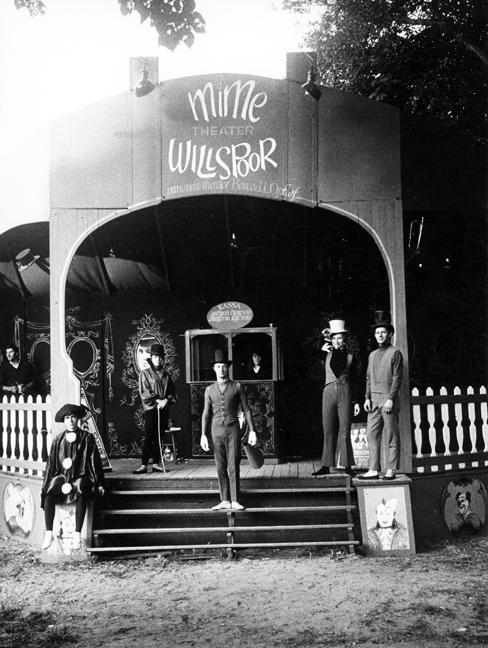 Jamie seated (in hat) on left side of picture
Jamie seated (in hat) on left side of picture
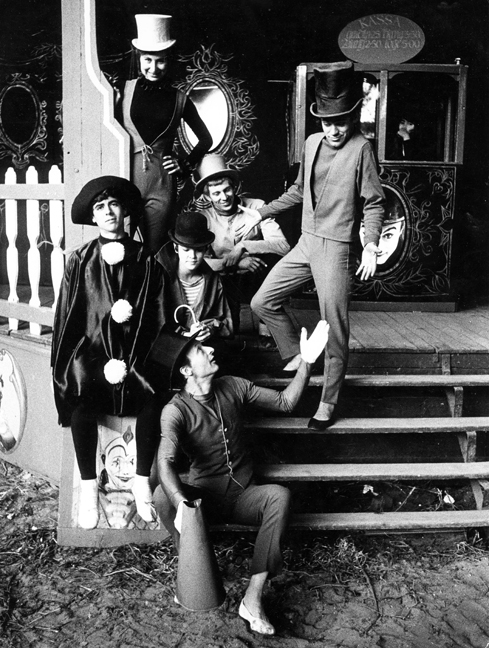 Jamie seated on left side of picture
Jamie seated on left side of picture
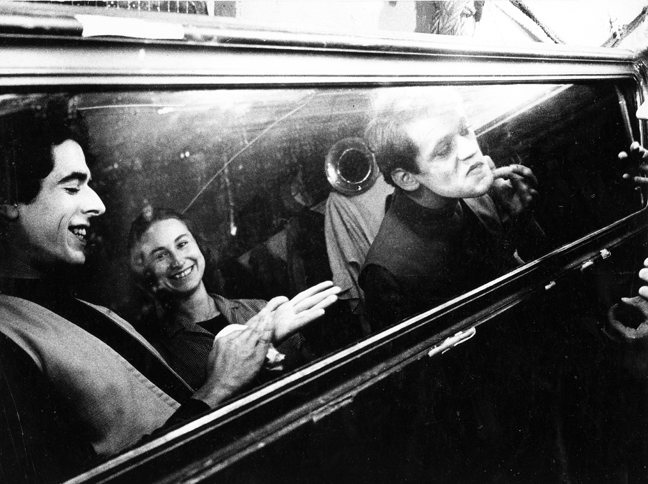 Jamie, on left side of picture
Jamie, on left side of picture
How did you afford the tent?
Actually it was bought for us by a wealthy Dutchman, Mr Heine, who was in the supermarket and coffee business. His only stipulation was that somewhere in the show we put in a mime piece about his coffee and we did. I was the coffee king who was given different coffees to taste and of course Heine’s was the one I preferred.
Amazingly, we did that damn ad in every show even though we never auditioned it for Mr. Heine and he never actually bothered to show up at the tent.
Where was the tent erected?
We did a summer season in Bergen op Zoom, a seaside resort town. Children would come around and try to talk to me before or after the show but I explained that: “ik sprek ingalls”—then when they saw me they would refer to me delightedly as the “Ingallsman” as if I was some wonderful creature. Maybe they somehow enjoyed the idea that the silent mime was really unable to speak to them.
During that summer the troupe all lived together in a lovely house on a street called the Doorntjes and I bicycled to the tent for performances. Yeka sat in the booth and sold tickets.
It was a happy, carefree life. I found great beauty in simplicity.
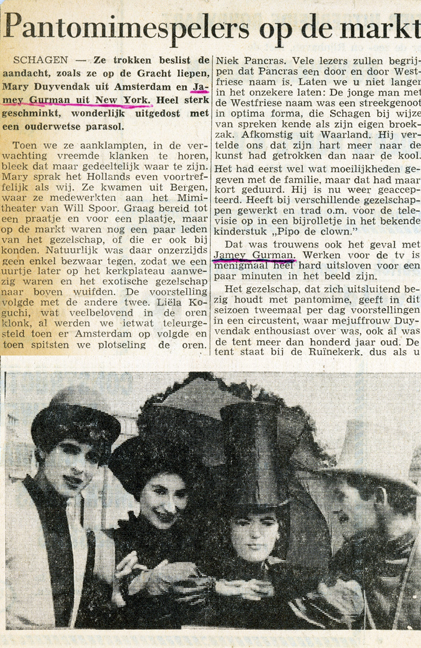 Dutch newspaper article about Jamie, and the Will Spoor Troupe (Jamie, left of the picture), August 1964
Dutch newspaper article about Jamie, and the Will Spoor Troupe (Jamie, left of the picture), August 1964
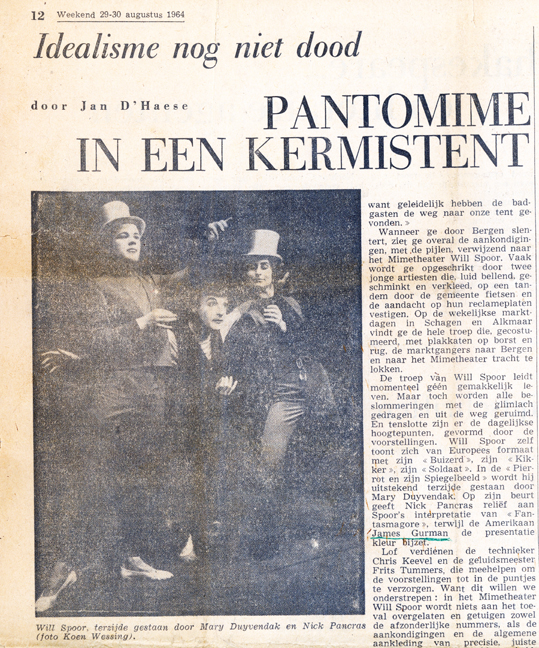 Dutch newspaper article mentioning Jamie and the Will Spoor Troupe, August 1964
Dutch newspaper article mentioning Jamie and the Will Spoor Troupe, August 1964
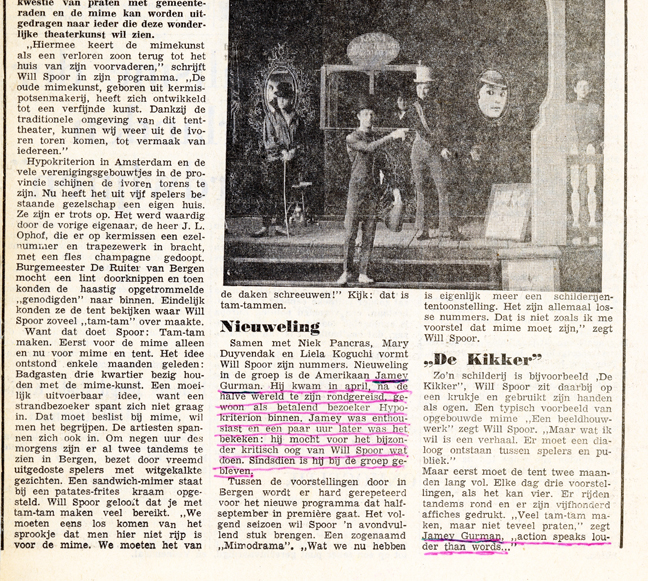 Dutch newspaper article mentioning Jamie and the Will Spoor Troupe, August 1964
Dutch newspaper article mentioning Jamie and the Will Spoor Troupe, August 1964
When did you decide to return to New York?
I had constant wanderlust, so with regret, I decided to leave the company and the Prinsengracht apartment after the season ended. I still wanted a mime career and I started studying with Moni Yakim.
In the summer of 1964, I went to see a free performance of the San Francisco Mime Troupe in Washington Square Park. The performance was not allowed to proceed because there was an issue with the permit. The performers were arrested.
I went up to a member of the troupe who was removing the posted signs that announced the show. He was much older than I was and asked him how much the performers made by passing the hat when they were allowed to perform.
He replied “$5”.
The combination of the guy’s age, the money, the arrests, and the fact that they were being refused permission to perform was crushing.
It was at that moment I ceased to be a mime.
Did you continue to enjoy mime, even though you didn’t pursue it?
Oh yes. It was a intimate and innocent art. I went to see Marceau perform again in Los Angeles in 1990 – and was astounded to see that the show he was doing was identical to the one I had fallen in love with as a nineteen year old. I felt sorry for Marceau. He seemed to be a sad, pathetic creature condemned to roam the world night after night, decade after decade, famously putting on and taking off a mask that wasn’t there.
I went backstage again – just like I had when I was 19. But this time let others bow to him while I watched from a distance and felt sorry for the mechanical man I had once revered.
But when he died, I was destroyed. I cried openly when I read his obituary in the New York Times.
I was crying for his loss, but also because I had lost that innocence that was once such a part of me. When I first saw him, I thought I had just seen the wisest, most spiritual human being in the world.
*
Jamie Gillis – The Theater Actor
When you decided against mime, did you gravitate back into theater?
No. I went back to school. First to get better high school grades; then to college. I was accepted to the Columbia School of General Studies – the branch of the school that accepts students who have knocked around a bit and now want to get a degree. I lived in a tiny apartment with my girlfriend on 105th between Riverside Drive and West End Avenue – a lovely landmark block near Columbia.
Why did you want to go to college?
I thought I may need a degree in case I needed to teach something like dramatic literature at some point. But my intention was to get straight back into acting right after I graduated.
I even took an acting course in what turned out to be the exact same room in which I was born. Columbia had taken over the woman’s hospital that had closed years before. I was born in that hospital and our classroom was the baby delivery room. I figured that was a divine sign that I was meant to act.
And you graduated?
Yeah, I ended up with good grades even though I knew well before graduation that I was going back into the theater no matter the cost. I knew it would be a difficult life, with plenty of financial hardships, but I was determined to do whatever I had to do to survive.
What was the first professional acting work you did?
In 1969 I saw a notice in Backstage about a group called the CSC (Classic Stage Company). They were in the Village on 3rd St in a converted shoe factory. I went over to audition. I did Edmund from King Lear: “Thou nature, art my goddess…” and I was accepted into the company in March 1970.
Didn’t you also get into Joe Papp’s Shakespeare Company in Central Park?
Yes, but I stayed with the CSC because I though I’d be a bigger fish there which would lead to bigger roles. Papp’s people told me I was crazy and that no one cared about the CSC. They were right I guess, but I loved the CSC.
I took a tiny closet-sized room for $17 a week at 148 Waverly Place just a short walk from the CSC theatre.
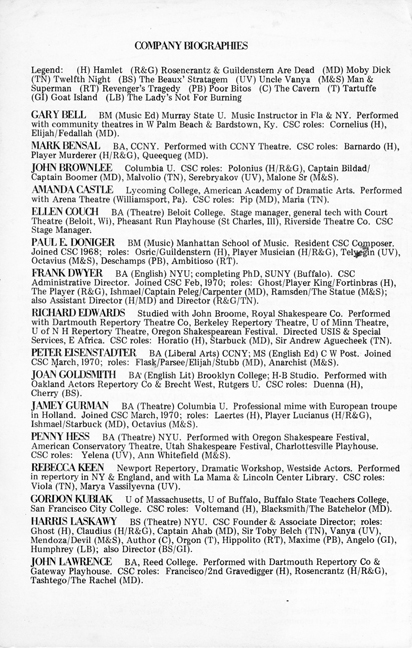 CSC – Biographies of the Actors
CSC – Biographies of the Actors
What was the CSC like?
Very small; very intimate. If a pretty girl in a short skirt was seated in the first row I could have a little concentration problem.
Many big-name actors passed through the company over the years, but in those days they couldn’t afford to pay any of us a salary. I stated driving a cab a few days a week to make ends meet.
What plays did you act in?
We pretty much did a different play every night, I appeared in ‘Hamlet’ as Laertes, in ‘Rosencrantz and Guildenstern Are Dead’ as Hamlet, in ‘Twelfth Night’ as Sir Andrew Aguecheek, and in ‘Moby Dick’, first as Starbuck and later as Ishmael.
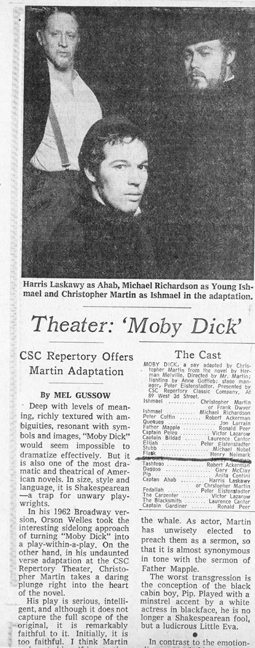 New York Times review of ‘Moby Dick’
New York Times review of ‘Moby Dick’
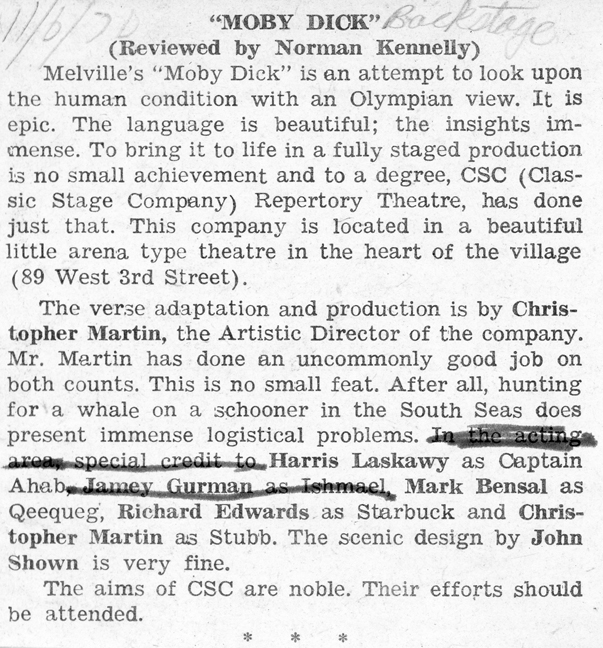 Backstage review of CSC production of ‘Moby Dick’, November 6th, 1970
Backstage review of CSC production of ‘Moby Dick’, November 6th, 1970
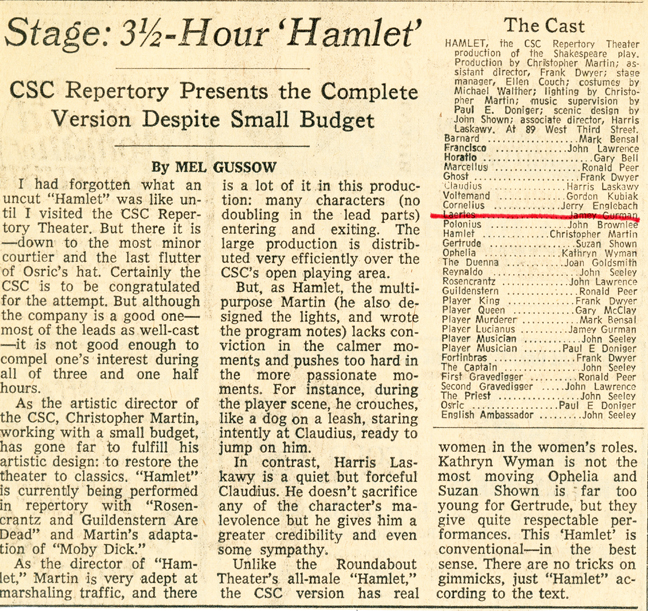 New York Times review of ‘Hamlet’
New York Times review of ‘Hamlet’
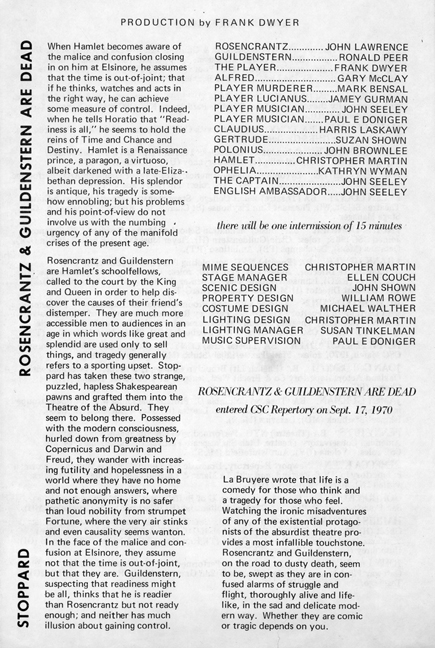 CSC production of ‘Rosencrantz & Guildenstern Are Dead’
CSC production of ‘Rosencrantz & Guildenstern Are Dead’
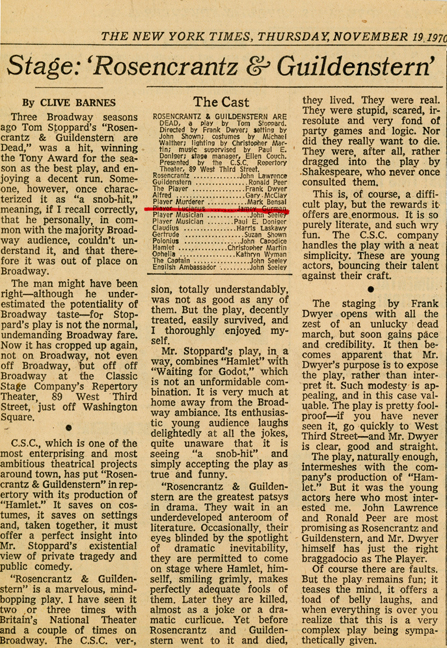 New York Times review of CSC production of ‘Rosencrantz & Guildenstern Are Dead’
New York Times review of CSC production of ‘Rosencrantz & Guildenstern Are Dead’
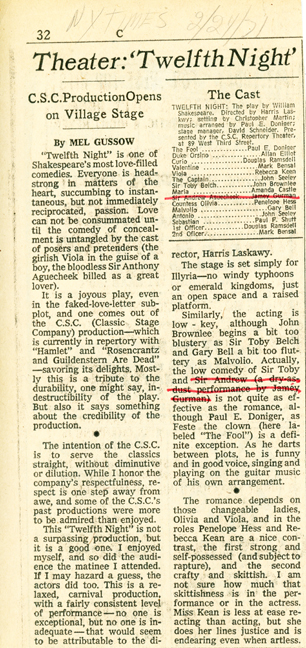 CSC production of ‘Twelfth Night’
CSC production of ‘Twelfth Night’
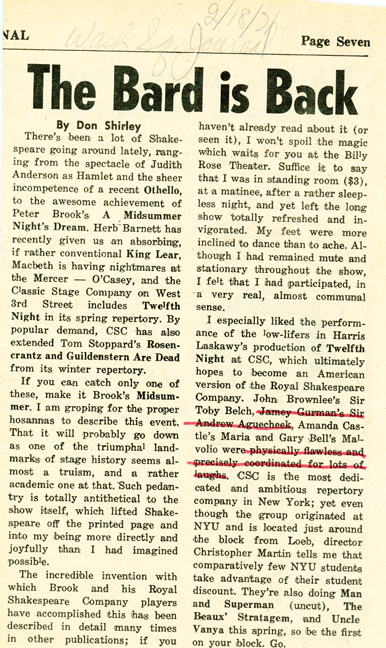 Review of Hamlet in Washington Square Journal, 1971
Review of Hamlet in Washington Square Journal, 1971
Did you enjoy your time there?
It was wonderful. I learned so much about acting and made many friends.
While I was at the CSC John Gielgud and Ralph Richardson were appearing in ‘Home on Broadway’. I went backstage to meet them because I thought it would be great for company morale if one or both of them could be induced to come see us in our little theater.
Gielgud was contemptuous and told me he had very little time to see anything, but Ralph Richardson was warmth and humor personified. He had a half empty bottle of vodka at the foot of his dressing table, and when I told him I was playing Sir Andrew Aguecheek he immediately leapt into the role of Sir Toby Belch which he had famously performed, and we bandied lines back and forth to my great delight.
I take it your career as a sexual performer that was ahead of you… was not expected at this stage?
I was always sexual, but at that time I was strictly a thespian!
I actually lost my girlfriend to one of the senior actors at the CSC, Frank Dwyer, for a short while. All the men at the CSC wanted Renee. She told me that after once fucking her a couple of times in rapid succession, Frank crowed: “I bet Jamie can’t do that”.
She coyly told him, “Jamie only does it once” and then floored him with:’” but he does it all night.”
How did your time at the CSC come to an end?
I saw an ad in Village Voice for nude actor work, or something like that.
That was placed by Bob Wolfe. He filmed 8mm hardcore sex loops in a dirty basement on 14th St.
I responded, and my career in porn films started. I still did plays from time to time, but in truth, there was no going back.
*
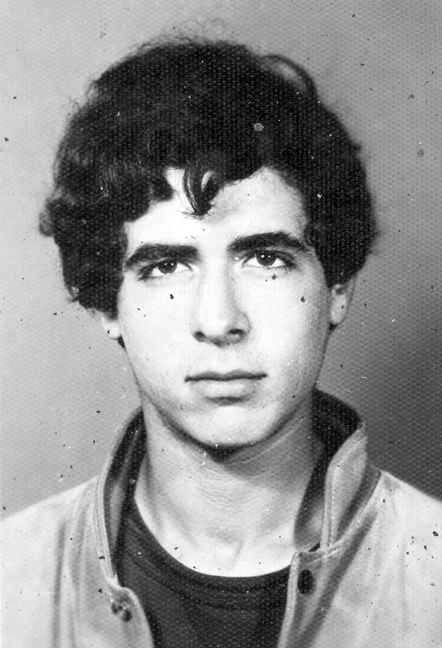
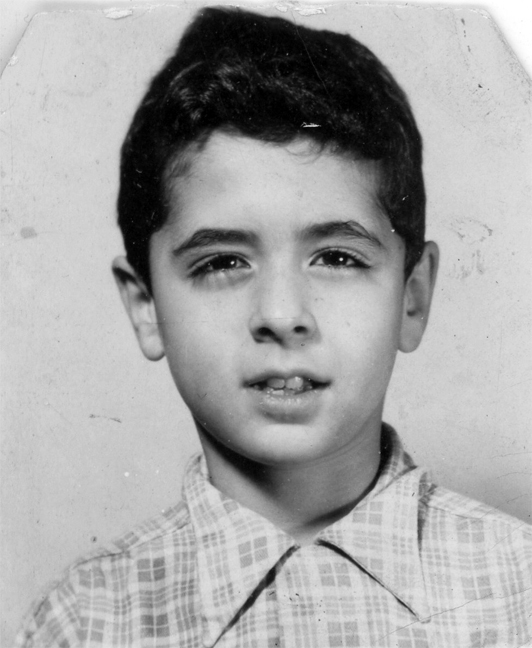
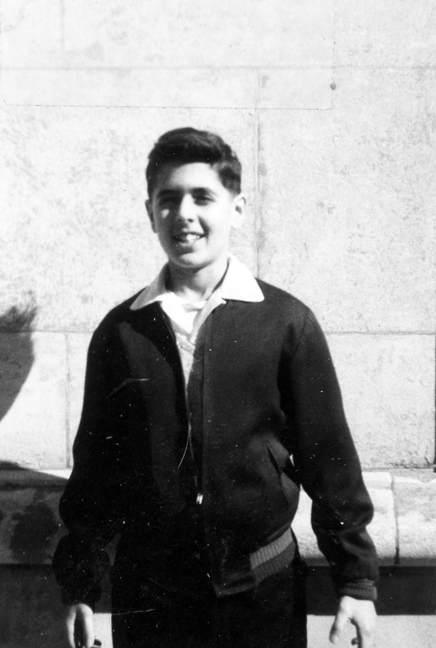
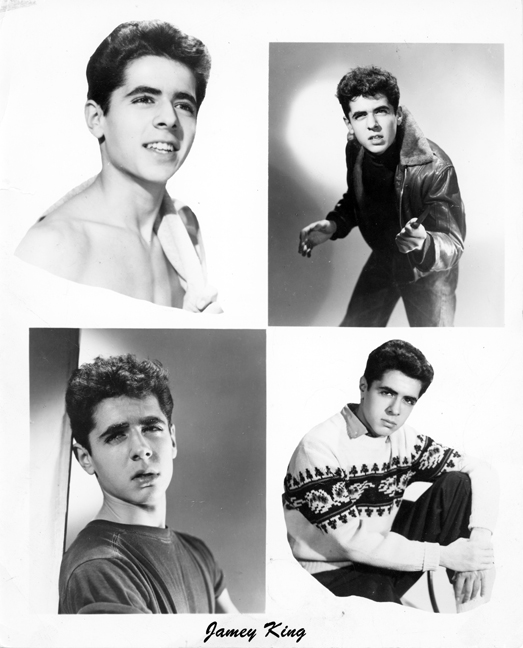
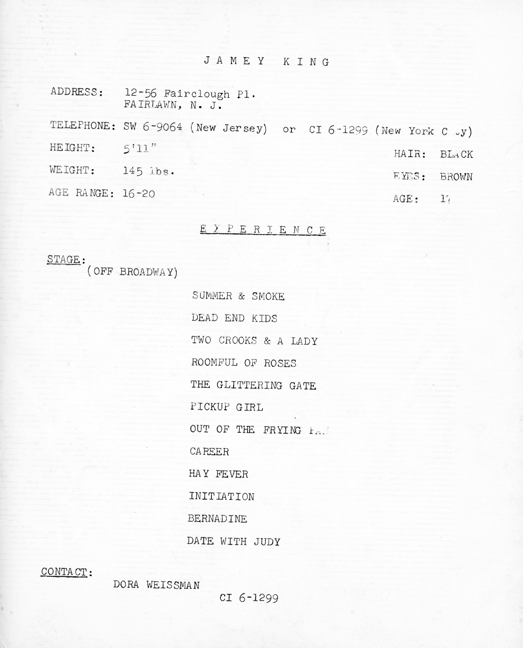
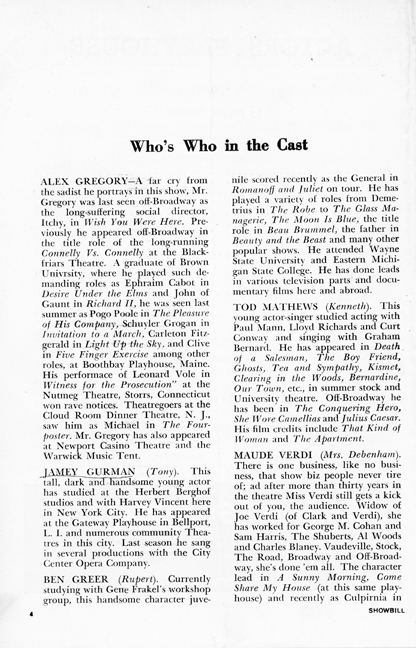
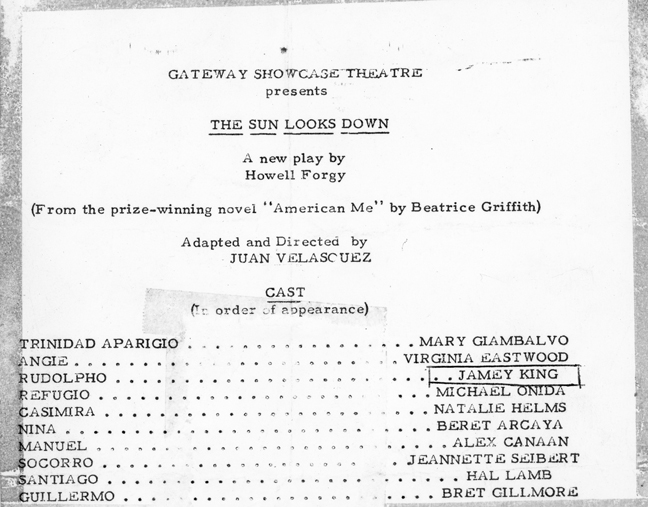
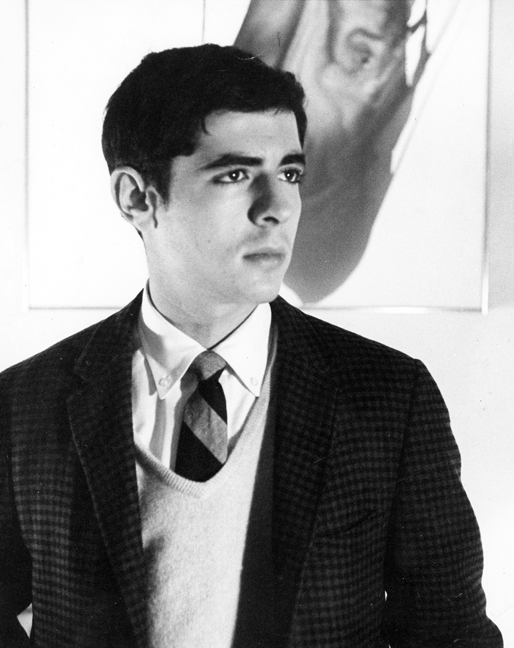
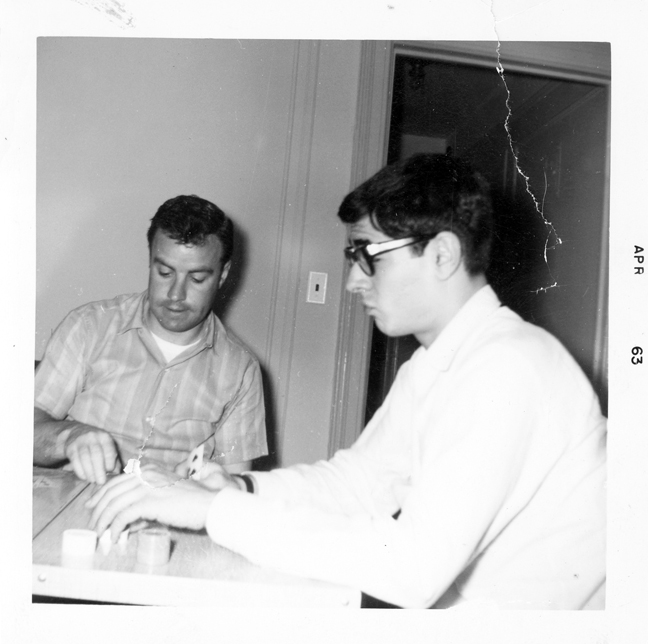
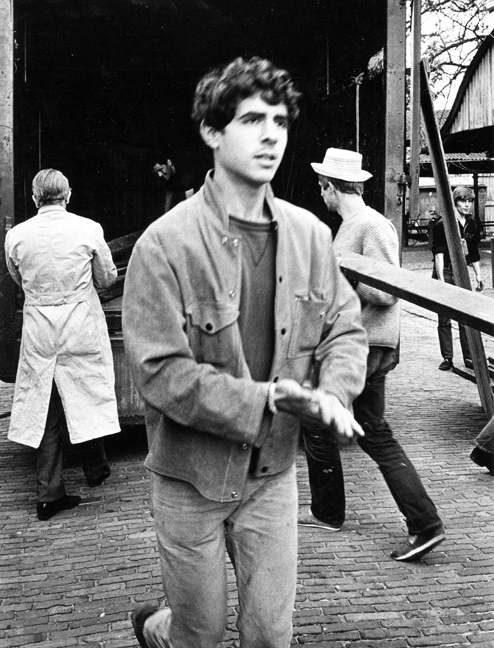
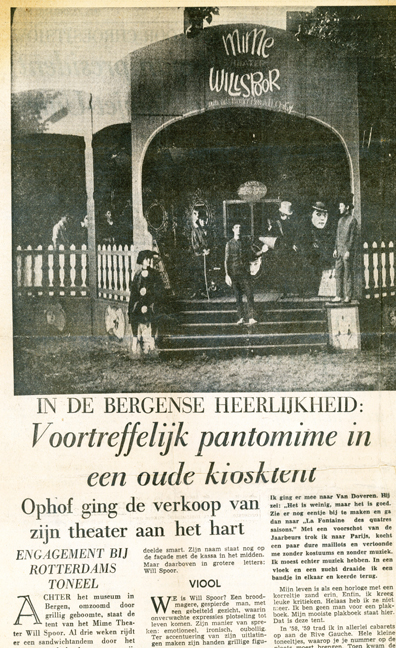
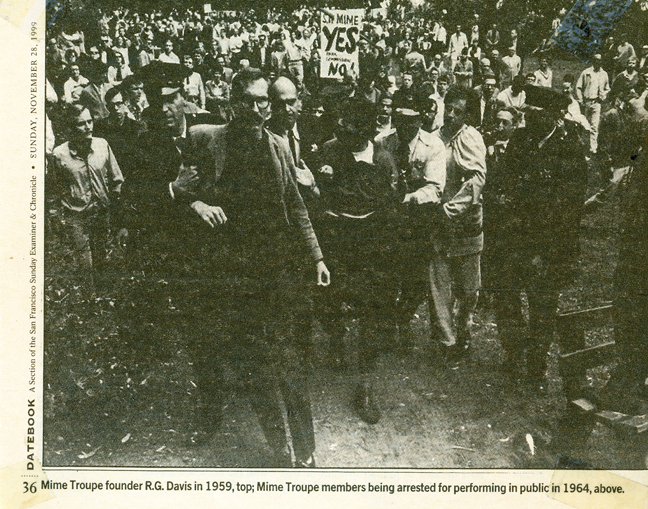
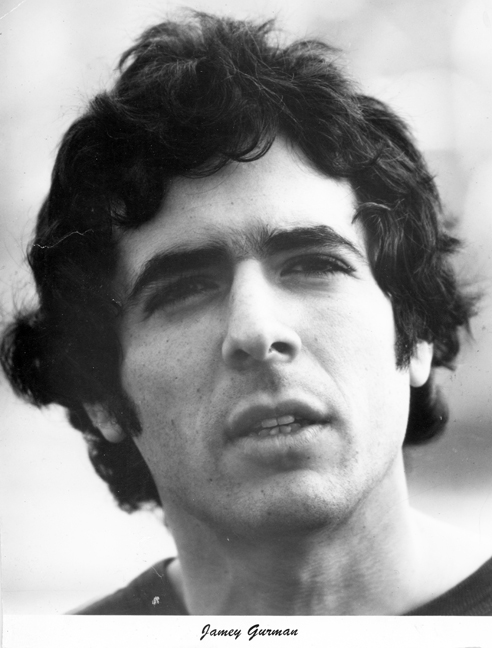
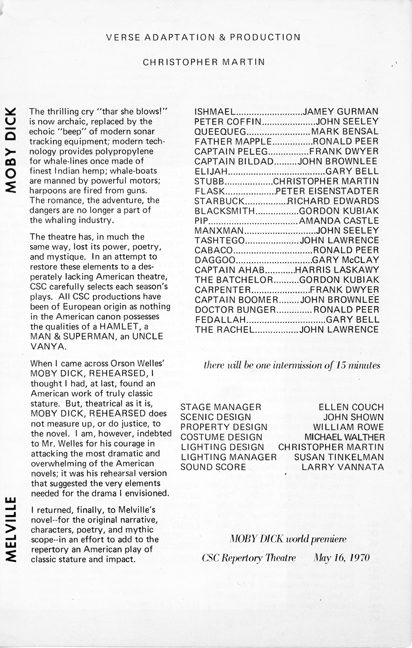
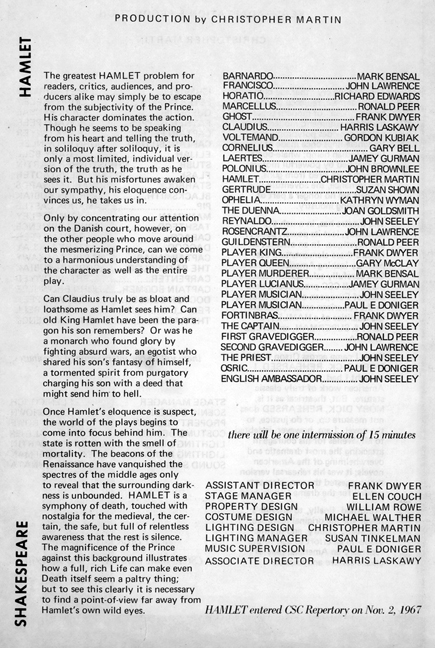
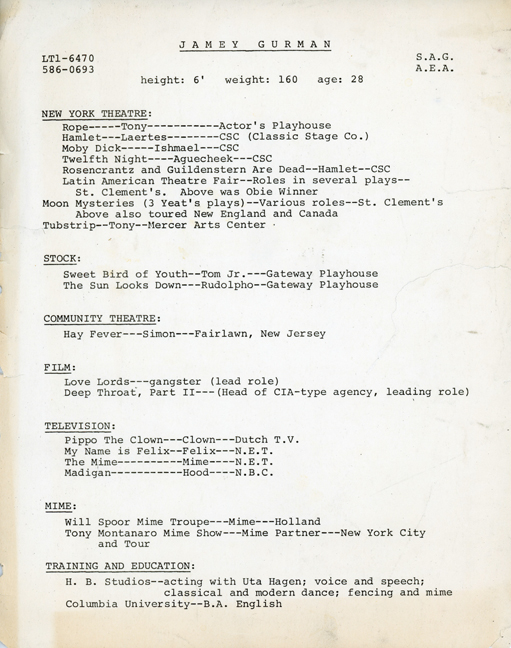
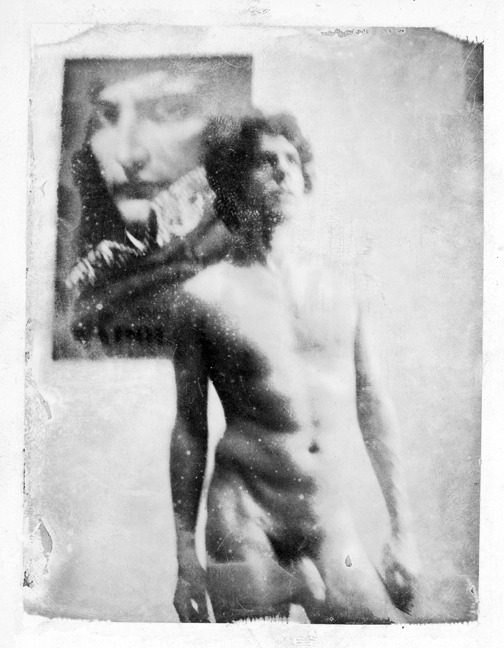
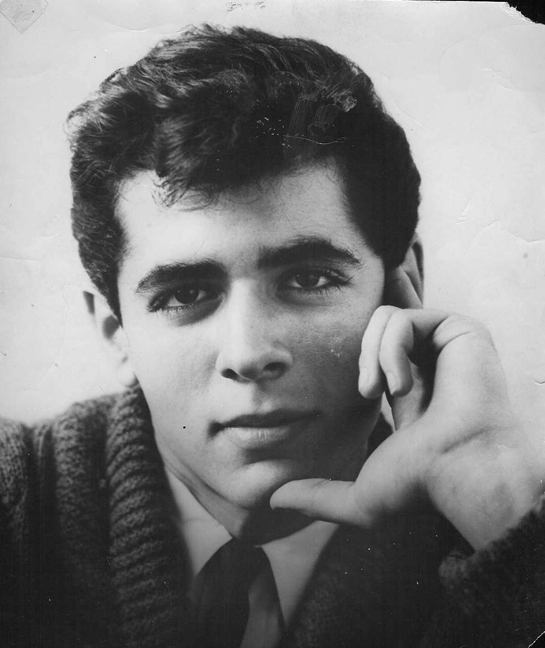
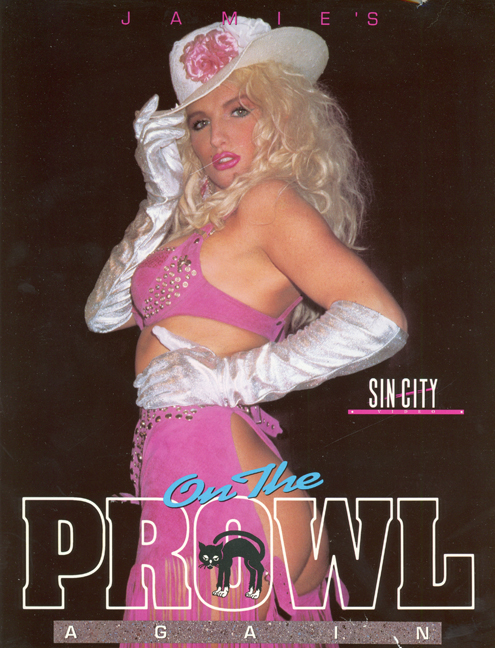
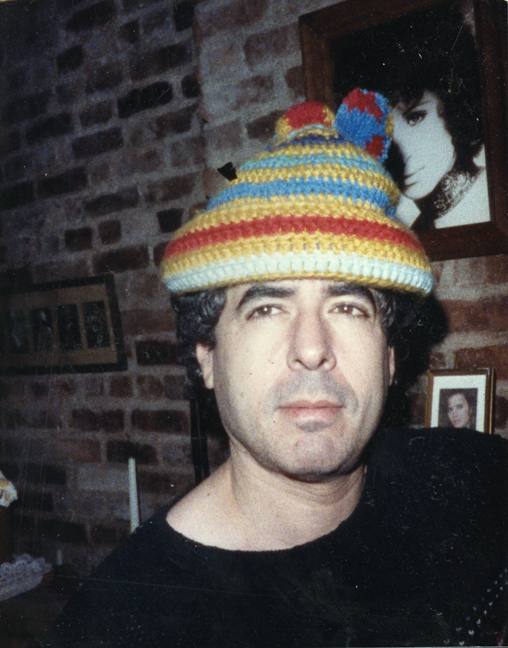

Absolutely bloody brilliant. The way you humanize the performers by showing us who they really were is nothing short of amazing. This is a beautifully curated and affectionate portrait of a person and a time and…. a life.
I’ve always admired Jamie Gillis, but never felt that I understood him until now. This subtle and short interview gave me an appreciation for who he was at heart, and I LOVED it. Really love this article. Thanks.
Bravo RR. A poignant and sweet fleeting memory of time gone by.
Permitless mimes arrested. Gotta love it. Jamie seemed so dedicated to his acting, and with his training it is easy to see why so many think he was the best actor in porn.
Awesome Article Keep Up Good work Ashley.
Thank you for yet another great post!
The history of adult films and their actors is as important as any other industry, probably more so as it touches at the heart of what it means to be human. Thank you for treating all of it with the care and respect it deserves, you guys should be proud of yourselves.
This post made me sad that Jamie didn’t achieve as much as he wanted from a craft that he put everything he had into it. It makes so much more sense why he had this presence and intensity in the films he was in, considering his passion for acting.
RIP Jamie, we remember you – you did good.
He was handsome, brilliant AND FEARLESS!!
You wet my beak for more, hope this is going to be in the book.
You never cease to amaze, RR!
I find Gillis (as a person) repellent, but I admire his passion.
He was a great person; I feel honored to have met him one night on Columbus Ave. in North Beach in SF ca. late 1990s….And, needless to say, he was a great performer, both above & below the belt!
I had the great pleasure of meeting Jamie at a Times Square (believe it was Howard Johnson, back in the dazed & confused, but stellar ’80’s) Approached him having bet a friend that we were in the presence of porn greatness. Jamie was cordial, friendly & with a wry smile wanted a piece of the action, in regard to the wager placed. I won $10 & much more importantly, the honor of meeting a legend of the Golden Age!!
I was initially drawn to this site for the obvious reason, but more and more I’m fascinated by any number of performer’s ‘origin stories ‘ – and Jamie’s is one of the most fascinating. An amazing journey. One can only hope there’s a biopic somewhere down the line that does him justice.
I noticed he studied under (or worked with) Uta Hagen. Would that be Nina’s thespian mother?
Thanks for bringing us this great piece.
I did Jamie’s first ever interview in Tom and Teddy Kariofilis’ office at The Capri Cinema. Most of our conversation was about Kant vs, Hegel, whether the Socratic idea was the best way of academic instruction and other adult film topics, until Teddy stormed in and said “When’re you two gonna talk about the damn movie!?”. To my discredit, when my editor didn’t accept the interview, I later lost the damn cassettte….